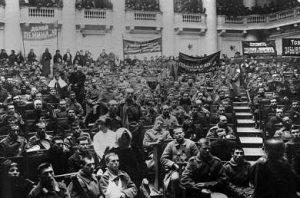Communist Workers’ Power Will Mobilize Masses to Build Communist Society

Petrograd Soviet of Workers and Soldiers During the Revolution
Sunrise over Petrograd on October 25, 1917 marked the dawn of a new era. The working class, led by its Communist Party, had driven out the capitalist Provisional Government.
Red-led workers, soldiers and sailors – along with “Left Socialist Revolutionaries” (SRs) and their rural base, began to build a new society. They had proved to themselves, to the world, and to the future that the days of wage-slavery were numbered.
But on October 25 the revolution had only begun. Soon “moderate” socialists would abandon the Congress of Soviets, the new organ of workers’ power. The capitalists would regroup and attack. The bitter political debates of the past year would turn into armed struggle. Groups supposed to be revolutionary (Mensheviks, SRs, Anarchists) would conspire to overthrow the Bolsheviks. They would support anti-communist rebellions organized by capitalists and other open reactionaries.
There was heavy fighting in Moscow before the Bolsheviks prevailed. The civil war began immediately. General Kaledin organized a rebellion of the Don Cossacks that the Soviet government defeated in January, 1918. By then, anti-Bolshevik forces were rallying in support of the bourgeois-led Constituent Assembly, which the Bolsheviks had disbanded.
In the spring, nationalist Czechoslovak Legions (with a base among railway workers) took power in Siberia, the Urals and the Volga region. By July, even the Left SRs and anarchists openly opposed the new government.
Then over 100,000 imperialist troops, from over a dozen capitalist countries, invaded Soviet Russia.
Bolshevik hopes for prompt and successful uprisings of European workers and soldiers were dashed.
Even more seriously, peasants rebelled against the Bolshevik grain requisition policies that started in 1918. Worst of all, SRs helped turn protests of Kronstadt sailors into open rebellion in March, 1921. This anti-communist revolt gained support from naval officers and even “White” counter-revolutionaries. They too used grain requisitioning as an excuse to attack Bolshevik workers’ power.
The Bolshevik government was able to suppress the Kronstadt rebellion because it had a mass base among sailors and workers in the port cities. Many ships refused to support the rebellion. Some sided with the Bolsheviks. On other ships, sailors fought their officers.
However, the New Economic Policy of 1921 was in part a response to the Kronstadt rebellion. Lenin described this as “progression to state capitalism.” For workers, however, it was a retreat.
Bolsheviks Win the War but Lose the Peace
The civil war– abetted by imperialist invasions – would rage for over three years. The Communist-led masses would win that war. They would inspire masses around the world – including us!
But they would lose the peace. They defeated themselves by implementing the historic communist line of building socialism as a “stage” in the development of communism. The Soviet masses themselves proved that line wrong in practice. We must learn the lessons of their heroic struggle and their tragic failure.
Socialism itself turned out to be capitalist in essence, not a path to communism. It rebuilt a money-based economy with a wage system that turned its communist leaders into capitalist oppressors.
The Bolsheviks didn’t build a mass base among rural workers, even when Bolshevik soldiers returned to their peasant villages. And they hadn’t tried to win the masses in the city or country to communism: “from each according to ability (or commitment), to each according to need.”
When the urban masses desperately needed bread, farmers refused to sell enough grain. So the Bolshevik government had to requisition it – by force. Their failure to mobilize masses for communism – eliminating money and markets – prevented them from overcoming divisions between rural and urban workers.
The Bolsheviks understood the importance of the super-oppression of masses belonging to minority groups. But they wrongly interpreted this as a “national question.” They didn’t grasp the need to destroy this racism at its roots by mobilizing masses for communism. Their mistaken line on nationalism prevented them from building international working-class unity.
State capitalism undermined early Bolshevik efforts to end sexism, class society’s special oppression of women among the masses. Wage slavery plus economic crisis forced many into subordination to men.
Concessions to nationalism, concessions to private enterprise, to bourgeois democracy –all prevented the realization of communism.
Mobilize Masses to Build a Communist Future
October 25 (old-style) is November 7th on today’s calendar. We celebrate that day because it showed so clearly that people like us – industrial workers, soldiers and all oppressed masses – can take power and shape our own destiny.
We have learned from the Bolshevik Revolution, most of all, that to build communism in the future we must mobilize masses directly for communism now and always.
We cannot compromise this policy by forming coalitions with other “left” groups around demands for democracy or reforms. We expect to exercise communist workers’ power by building a mass International Communist Workers’ Party.
Let’s draw everyone we can into discussions of how to make this work. How will the Party mobilize masses directly for communism where we have power? How do we expect decisions to be made?
Who will give leadership? Who will be in the Party?
The short answer is: YOU and many millions like you.
We will find the long answer together.

Front page of this issue


